|
Only the granite gate leads from the 3rd portico to the upper
terrace. The terrace which is named "wshyt Hbyt =
Court of the Feast" is compromised by a central court which is
surrounded on all sides by a colonnade (see below). |
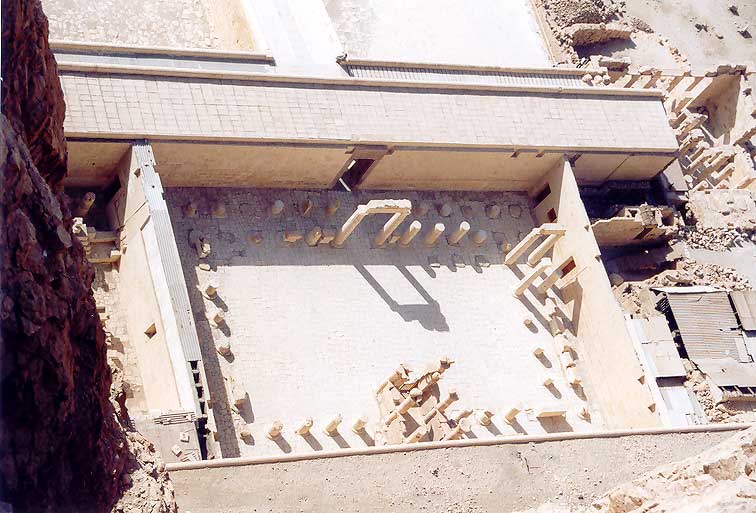
|
View from the top of the surrounding hill down to the 3rd terrace.
|
|
Seen from the entrance (above in the photo) three complexes can be
separated. On the southern side (left side in the photo) there are the
room with the window and the mortuary cult chapels of
Hatshepsut and Thutmosis I, opposite to the entrance on the western
side there is the main sanctuary of Amun and at each northern and
southern end of the wall another chapel of Amun, at the northern side
(left side in the photo) there are the sun altar and the upper Chapel
of Anubis.
|
|
Originally, the inner colonnade of the terrace was composed by two rows of polygonal
(16.sided) columns (Pawlicki, 1999).
However, Hatshepsut later added a 3rd row along the eastern wall. This
emphasized the entrance to the royal cult chapels on the south side and created
a new axis between the royal cult chapels and the solar complex (see below). |
| All the columns hat the same diameter at the base of about 80
cm and the same height of about 495 cm. Only the columns of the inner row - directed to the courtyard - were decorated
with panels showing on their upper parts the royal
falcon sitting on a serekh and wearing the Double Crown (here to be
seen on the photo below on the two columns in front of the granite
gate; see also pillars of the 1st portico
on this page). Apart from the name of Hatshepsut the name of her
father, Thutmosis I, and that of her coregent, Thutmosis III, appear
on the columns.
|
| As far as preserved figures a deity of the Nile (@apy)
carrying a tray with offerings and kneeling on a sign for Gold (see below) were
depicted further down. The head of the Nile gods depicted on the southern half
of the court were crowned with the plant of Upper Egypt (Lotos), on the northern
half they are crowned with the plant of Lower Egypt (papyrus). |
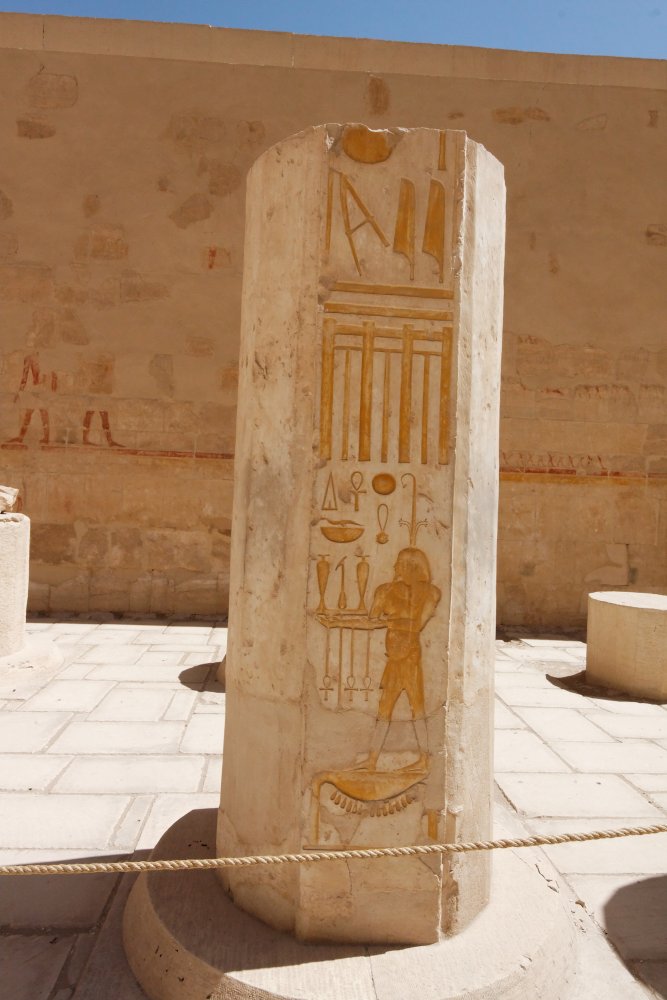
|
Decoration of a column from the southern half of the Court of the Feast - here
the Nile deities are crowned with Lotos plants. |
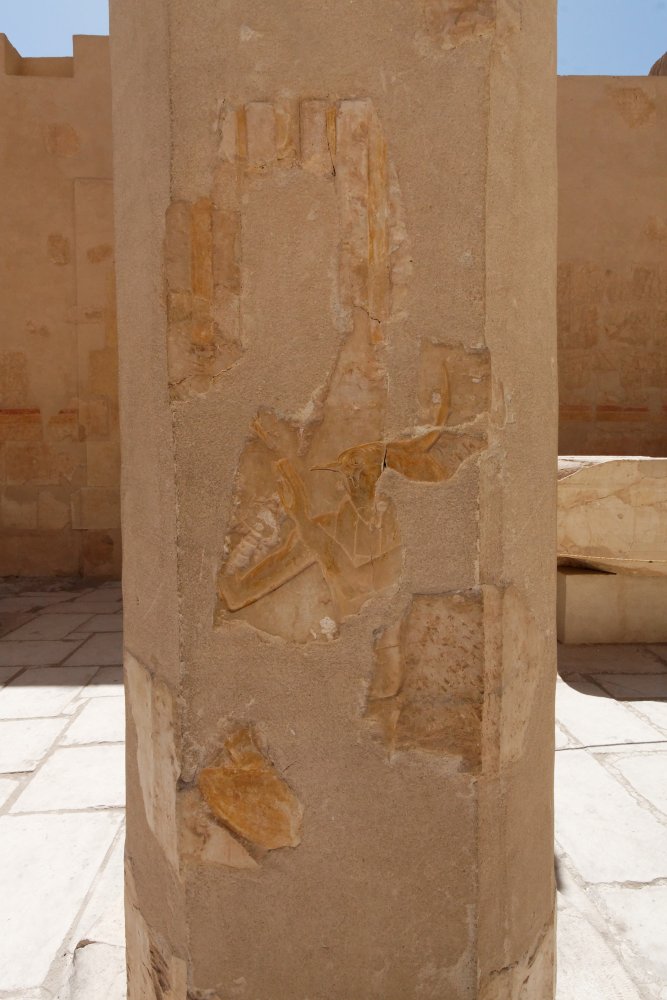
| Remains of a rxyt-figure on a column right (west) of the
passage to the royal cult chambers. Above the rxyt-figure this column
shows the name of Thutmosis II (originally Hatshepsut) and on the 2nd vertical
line of text which is directed to the passage the name of the terrace "wshyt
Hbyt
= Court of the Feast". |
| The two columns right and left along the passage to the
mortuary cult chapels of Hatshepsut und Thutmosis I were decorated with human
figures with a bird's head (rxyt) kneeling on
a signs for gold (nbw). These figures are facing each other i.e. they are looking towards the
passage. |
The upper terrace is clearly dominated by two axis. The
east-west-axis follows the processional way through the granite portal
to the lined-up rooms of the mains sanctuary of Amun, i.e. it traces
the way taken by the bark of Amun to the temple of Hatshepsut.
The other, south-north-axis starts on the south side of the temple in
the vestibule in front of the mortuary cult chapel of Hatshepsut or in the chapel
itself and runs to the north side and ends in the Solar Cult Complex
or in the Northern Chapel of Amun. This is the "royal axis"
which symbolizes the posthumous way to the north where the king is
resurrected and is welcomed in the realm of gods.
|
|
Unknown is the function of the undecorated "Room with (the)
Window" located in the south-eastern corner of the upper terrace.
Earlier this room has been described as the "Room with the Window
of Appearances" (see also LÄ, Vol. I, C. 1022). However, the earliest known
scenes which definitely show a "Window of Appearances" date
from the times of Akhenaten. The scenes show Akhenaten and his
queen, Nefertiti, at a large window of the palace while Akhenaten is awarding the "Gold of Honor"
(southern tomb of Parennefer, No. 7 at Amarna; and tomb of Ramose,
TT55, at Thebes-West).
|
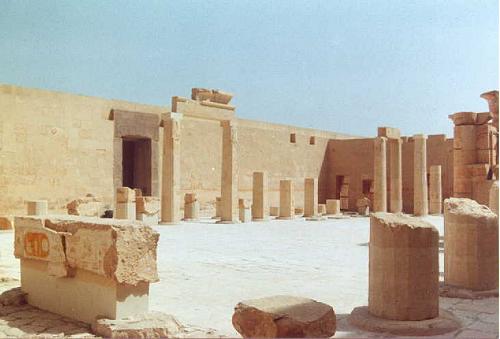
|
The upper courtyard is called in the inscriptions that have been
preserved as the Festival Courtyard which of course refers to the
"Beautiful Feast of the Valley". Correspondingly, the scenes
of the procession on the occasion of the festival take up much space
of the decoration of the upper terrace. The procession started in the
temple of Karnak, this start is depicted on the northern end of the
east wall (on the lower registers of left side shown in the photo
above). The next scene shows the procession of the barque of Amun
accompanied by priests and by statues of the royal family. Large space
is used to show the crossing of the Nile - two royal oar-driven ships
tow the bark "Userhat" (a kind of "Floating
Temple") with the statue of Amun and the royal bark. After
crossing the Nile the procession continued on a canal which ended at
the border of the green land. On the dike along the canal noblemen und
priest who were carrying the royal throne and fans followed the barks. The
barks were protected on their way by armed soldiers and sailors.
|
|
The scenes of the "Beautiful Feast of the Valley" are
continued with a new procession of the barque of Amun on the north
wall of the upper courtyard. Some details of the scene have been
survived on the north wall in better condition than on the east wall,
for example the presentations of the deceased and the living members
of the royal family. Here again the figures of Hatshepsut had been
replaced (most likely during the restoration work done under Horemheb)
by processional barques of Mut and Khonsu. The next scene shows
the barque of Amun resting at the way-station between the canal and
Djeser djeseru. Thereafter, the barque of Amun is shown resting in the
main sanctuary at the upper terrace and, finally, the return journey
to Karnak is depicted.
|
|
The southern end of the east wall (in the photo above the right wing) shows a short version of another
Theban feast, the "Beautiful Feast of the Southern Opet"
during which the statue of Amun was carried from the temple of Karnak
to the temple of Luxor. The scene show the procession of the bark of
Amun and the purification rites performed at the 6 way-stations which
Hatshepsut had erected along the processional way to the temple of
Luxor. Back to Karnak temple the statue of Amun was carried downriver
on the bark "Userhat".
|
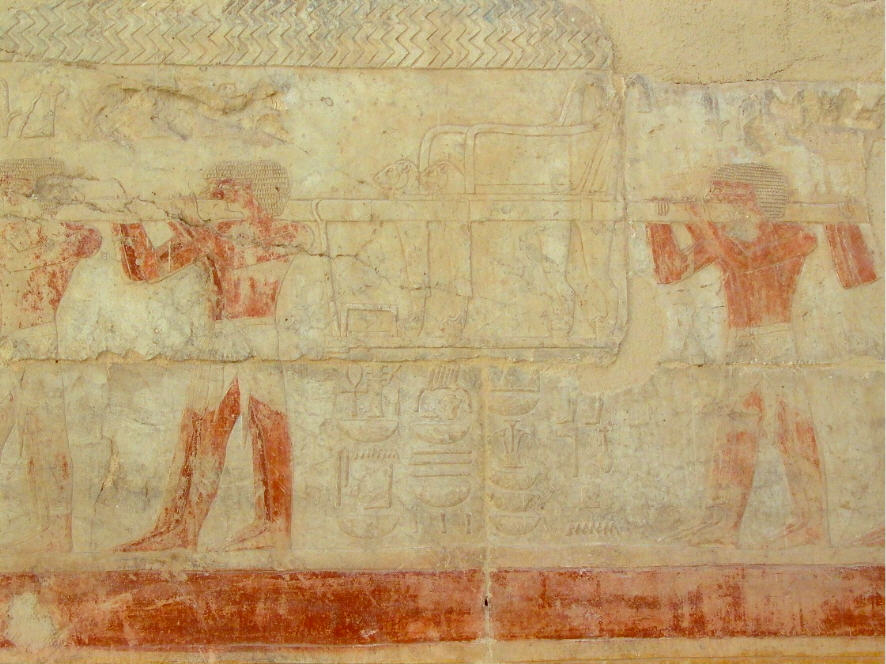
|
The photo above shows sedan-chair carriers from the Opet procession.
|
|
The decoration of the walls of the upper courtyard show in the parts
that have been preserved that the scenes had been reworked after the
death of Hatshepsut. In most cases the figures of Hatshepsut had been
replaced by text of offerings so that Thutmosis III who was depicted
together with the queen in most of the scenes became the leading figure
of the scenes.
|
|
The south wall of the courtyard was decorated with religious
ceremonies which must be seen in connection with the mortuary cult chapels of
Hatshepsut and Thutmosis I which also lie on the south side of the
upper terrace. The direction of the scenes follow the main-axis of the
temple, that is the king moves from left to right, i.e. from the
outside to the inner side of the temple - with the exception of the
scene next to the room with the window. Here Hatshepsut -
now reworked to Thutmosis II - turns left directly to the window and
consecrates offerings.
|
|
The west wall of the upper courtyard differs from all other walls
because it forms a monumental facade for the main sanctuary of Amun-Ra
which is located in the middle of the wall. The granite portal of the
sanctuary divides the facade
into two halves which each has 5 tall and flat niches as well as 4 low but
deep ones (see photo below). A torus roll separates the niches from
each other. The niches are "counted" from south to north by
characters, the tall and flat niches have gotten the characters: A, C,
E, G, I, J, L, N, P, and R, the low but deep ones the characters: B,
D, F, H, K, M, O, Q (see also Porter&Moss, II, 340ff, plan XXXVII).
|
|
A cavetto cornice (torus moulding) crowns the wall. |
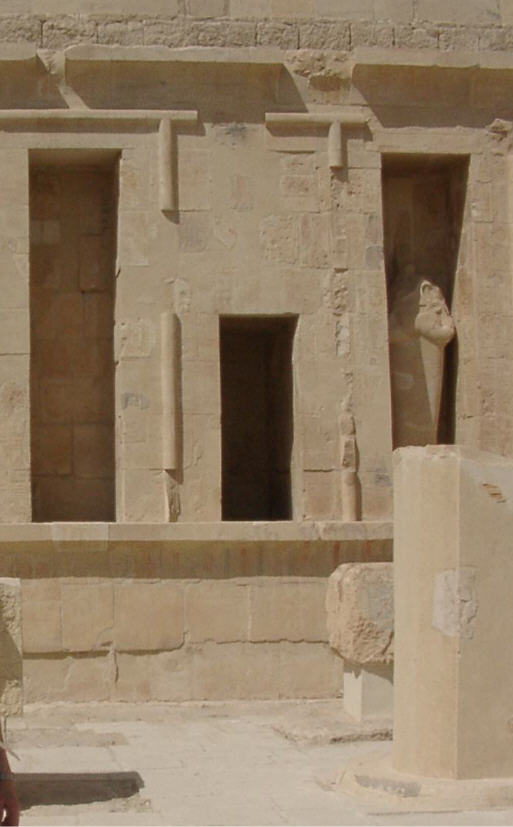
|
In the high niches osiride statues of Hatshepsut (see right niche above) were
put up from but only fragments of the statues have survived. These show
Hatshepsut wrapped-up like a mummy as demonstrated by comparable statues (e.g.
see main
sanctuary of Amun-Ra).
Her arms are crossed over the chest and in her hands she holds a whisk and
an Ankh-sign or Heqa- and Was-scepters. On the right (north) side of the wall the statues probably carried the
crown of Upper Egypt, on the left (south) side probably the double-crown.
|
|
The side panels of the high niches show in
each case and in two registers arranged one above the other gods of the
Ennead of Thebes who turn inwards i.e. towards the statues of
Hatshepsut. The gods of the Greta Ennead are shown offering favors to the
statues which show Hatshepsut as an eternal ruler. |
|
The lateral borders around the high niches contains two columns of
text in which the temple Djeser djeseru is repeatedly called
"House of Million of Years" (Ullmann, 2002). The architrave
carries a winged sun (see below).
|
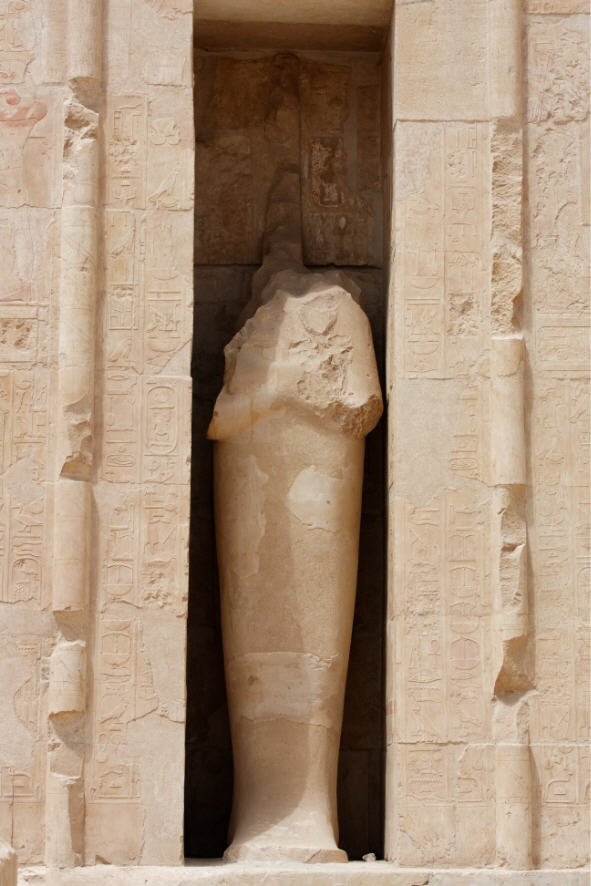
| Middle (3rd) niche on the north side of the west wall.
The lower part of the Osirid statue of Hatshepsut is quite good preserved.
Above the left shoulder the remains of her cartouche are still well readable.
It is assumed that also these cartouches behind her head were destroyed
during the reign of Thutmosis III, however, due to the limited space behind the head
they had not been re-carved. Surrounded by the torus rolls there is one of
the dedication texts of the temple.
|
| One of the decication texts reds according to Grallert (2001; Hat/Wf020):
"MAat-kA-Ra, jrjn[s] m mnw[s] n itj[s] Imn
[nb nswt tAwj] irt nf [hwt]-nTr aAt HHw
m rnpt Hwt Imn _sr-dsrw m jnr HD nfr
n anw m stf [Axt nt sp tpj]...
= (Work done by) Maat-ka-Ra, which [she] made as [her] monument for [her] father Amun,
[Lord of the Thones of the Two [Lands], (i.e.) the erection of a "House of Million of Years"
(called) Temple of Amun of _sr-dsrw made of limestone on the [effective]
place [of the first time]...". Other dedication texts on the surrounding registers
may differ a little bit from this one, for example, give different titles for Amun. |
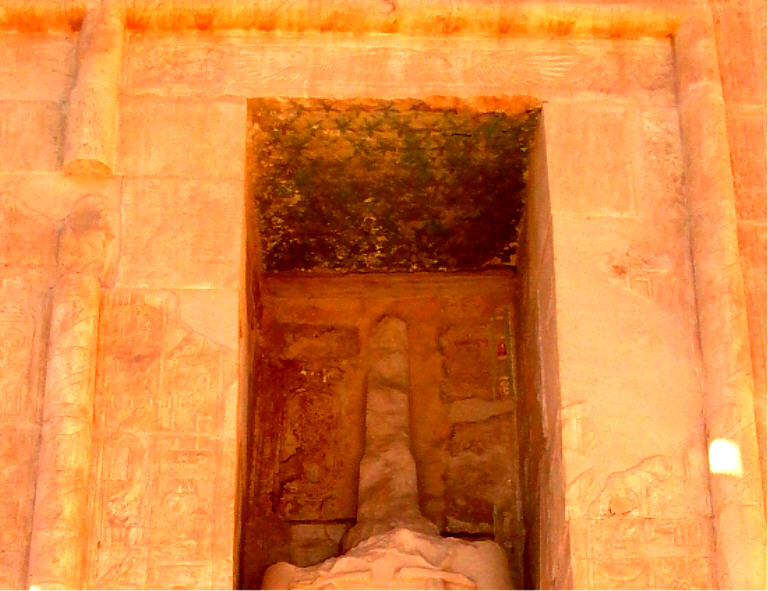
|
This reworked photo above shows part of the remaining columns with text and
the winged sun disk above one of the high niches.
|
|
The floors of the small niches do not show any traces of permanently
installed stony statues. Thus, it is assumed that small, portable
statues of Hatshepsut - and most likely other members of the royal
family - had been put here which had been taken out and carried around
during festival processions like the "Beautiful Feast of The
Desert Valley".
(Pawlicki, PAM 1998).
|
|
The scenes on the back walls of the small niches show Hatshepsut accompanied by two gods of the Ennead of Thebes. On the
northern part of the wall the queen moves southwards, on the southern
part she moves to the north - so she moves on both sides in the
direction of the sanctuary of Amun-Ra.
|
|
The lateral walls of the small show identical scenes which are already known
form the Old Kingdom. On the sidewalls Hatshepsut or a member of her family is shown enthroned in front of a
table with offerings. The rites are performed here on the left
sidewalls by the Iun-mut-ef or on the right by Thot.
|
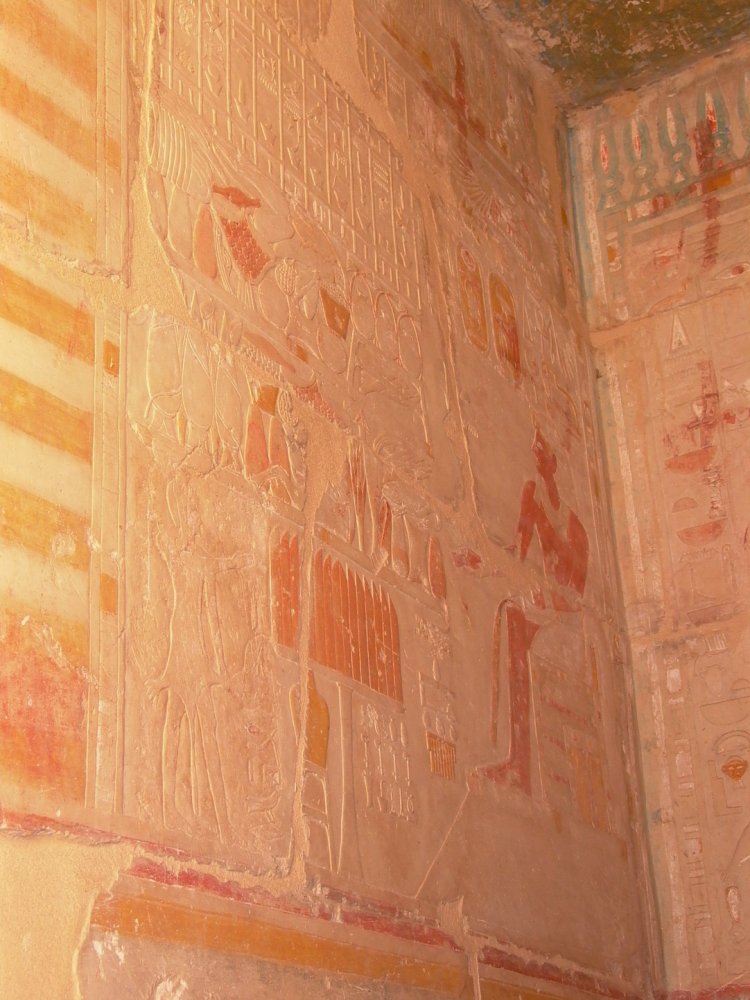
|
The photo shows the left wall of a smaller niche with Thutmosis II in front of a
table with offerings and Iun-mut-ef who is consecrating the offerings.
|
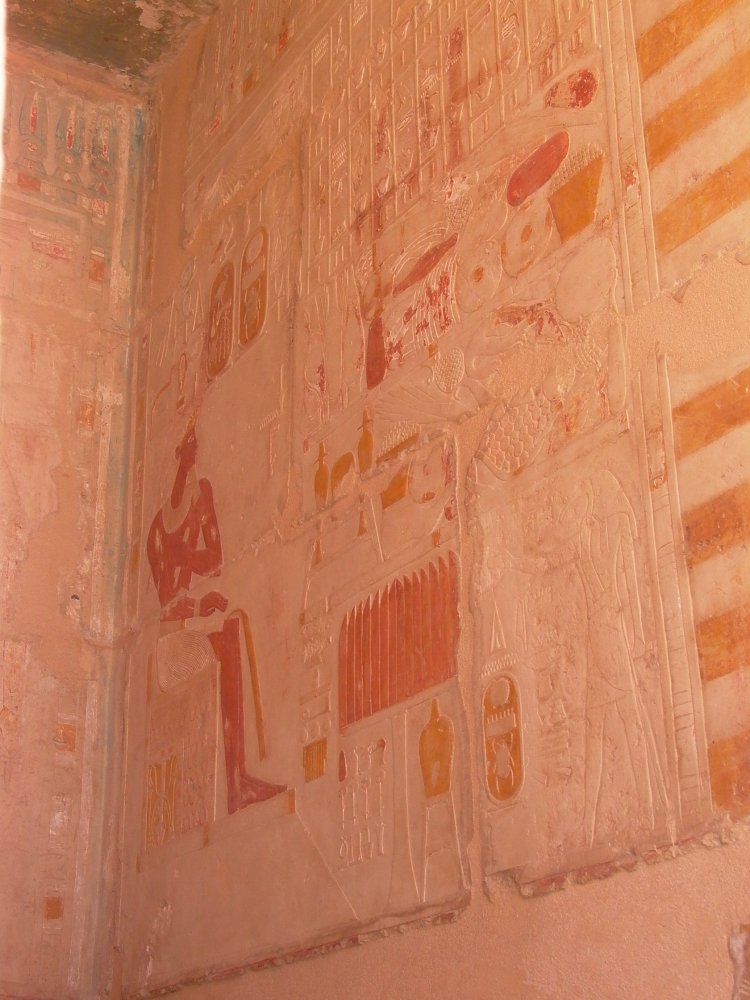
|
The photo from the right wall of the same niche shows Thutmosis III in front of
a table with offerings and Thot who is consecrating the offerings.
|
|
The niche H which is on the southern half the next small niche to the main sanctuary shows
a different decoration. The left sidewall shows Thutmosis II enthroned
and Thutmosis III is performing the rites in front of his father
Thutmosis II. The right sidewall shows in one register the same scene
- but with Thutmosis II enthroned in front of the offering table and Thot doing the rites
- and in another register an offering in front of Amun.
|
|
The small niches are also surrounded by two vertical lines of text
showing name and titles of Hatshepsut. Again the architraves carry a
winged sun disk.
|
|
Grooves discovered in the floor force to conclude that the small
niches could be closed by double-winged doors - and behind the doors
in each niche of course, the kneeling Senenmut had been depicted
(today, the scenes are destroyed). |
|
Furthermore, at the west wall of the court two interesting scenes are flanking
directly the entrance to the Main Sanctuary of Amun, on the left of (south) and
on the right of (north). Both scenes, which showed up only after the walls of
the Ptolemaic portico were dismantled, show a mother of the king (mwt njswt)
who is clearly identified by the cartouche as Ahmose, mother of Hatshepsut (see
photo of the southern scene). |
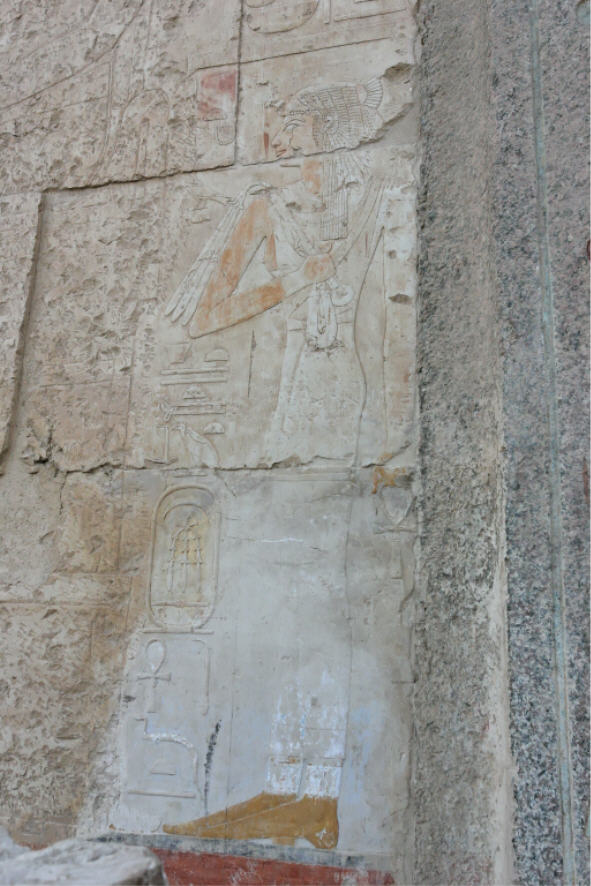
|
Especially the investigations of the southern scene showed that the figure and
the cartouche were altered. Under the sky- (pt-)sign a woman is shown, the body
painted in yellow and dressed in a long white tunic. The headdress, which
originally consisted of a diadem and a modius (= calathos) on the top of a short
curled wig, was changed into a vulture headress. In the right hand she carries a
Hts-scepter and a mnjt-necklace, in the left a HD-mace and
formerly the sistrum of the goddess Hathor (changed into an anx-sign; see
photo below). |
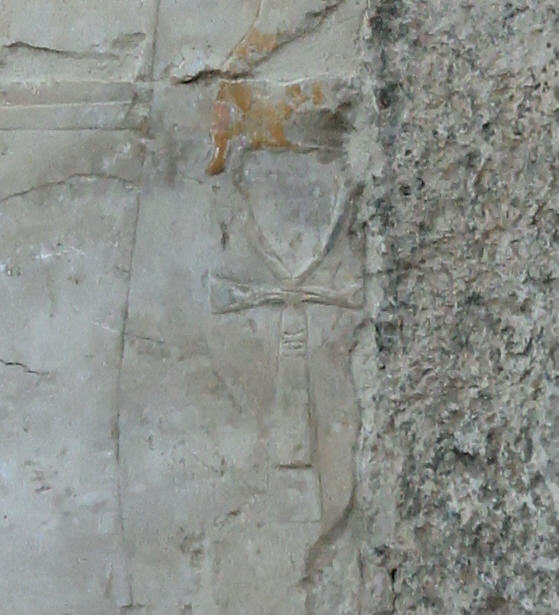
| Traces inside the cartouche revealed that the name originally
had been that of Neferu-Ra, daughter of Hatshepsut (Szafranski,
2010) |
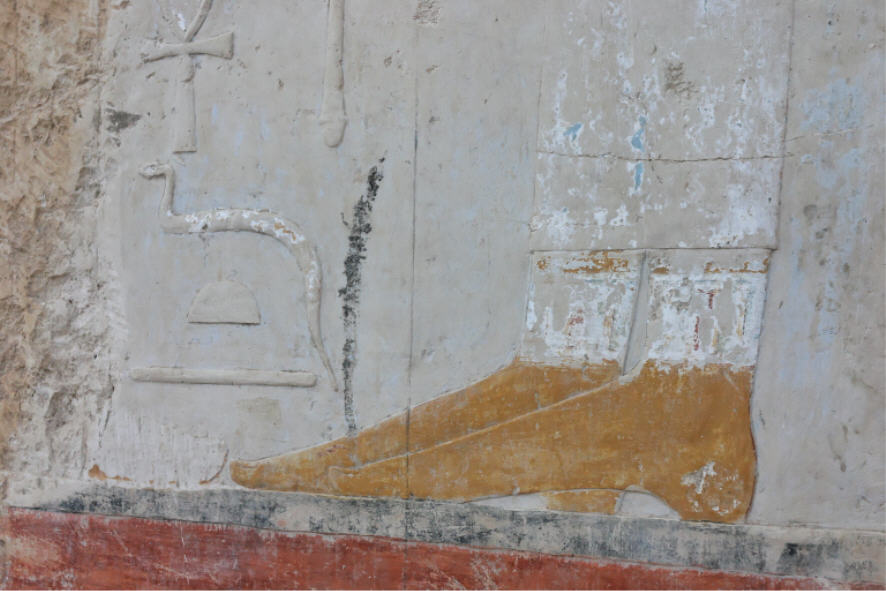
|
A special detail is to be recognized at the bottom of the southern scene. A
female figure stood once in front of Neferu-Ra, about twice as largely as the
figure of the princess. Of this figure only one toe painted in yellow has
survived. Szafranski (2010) assumes that this figure represented a goddess -
most likely Hathor - facing the princess. Behind the goddess he expects a
further figure, which represented - with almost certainty - Hatshepsut. |
|
Thus, in the original version the scene probably showed Neferu-Ra receiving at
the entrance to the Main Sanctuary of Amun the goddess Hathor followed by the
queen Hatshepsut. According to Szafranski (2010) the meaning seems clear: |
|
The future Queen Neferu-Ra receives the goddess und the present ruler! |
|
Thus, on the upper terrace clearly to different cult-axes can be
identified:
|
|
- an east-west-axis, which is marked by the way the holy
barque of Amun took on the way from the temple of Amun at Karnak to the Main
Sanctuary at Djeser djeseru, and
|
|
- a north-south-axis, from the
solar cult complex in the north to the mortuary cult chapels of
Hatshepsut and Thutmosis I in the south, which clearly is of
royal-solar character.
|
|












